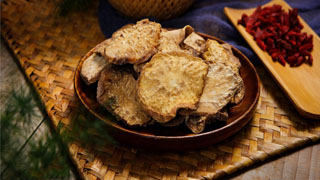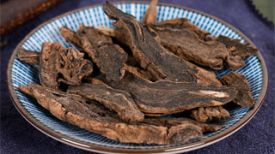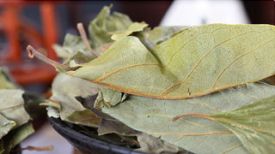
1. Aliases
Cistanche, Dayun, Desert Cistanche, Rousong Rong, Zongrong.2. Plant morphology
Perennial parasitic herbaceous plant with thick, flat, single fleshy stems, wide lower part, gradually becoming thinner upwards. The scale leaves are light yellow white, arranged in a spiral shape, without a stalk. The lower leaves are tightly arranged, broadly ovate or triangular ovate, while the upper leaves are sparse, linear lanceolate, 1-4 cm long and 0.5-1 cm wide. Spike inflorescence grows at the top of the stem, with 1 bract per flower, accompanying the leaves; Bracteoles 2, narrowly linear, base fused with calyx, calyx 5-lobed; The corolla is tubular and bell shaped, with 5 lobes at the top. It is yellow white, light purple, or has a light purple edge. There are 2 longitudinal bright yellow protrusions inside the tube, and there are 4 stamens, 2 strong, and the ovary is superior. Capsule ovoid, brown, with many seeds, small, and glossy. The flowering period is from May to June, and the fruiting period is from June to July.
3. Origin distribution
Born in the desert, parasitizing on the roots of the quinoa family plant Suo Suo (salt wood). Distributed in Inner Mongolia, Shaanxi, Gansu and other places.
4. Harvesting and processing
Both spring and autumn can be harvested, with the best harvest being from March to May. If it is too late, it will be hollow. After harvesting, let it air dry until it turns from yellow white to brownish flesh, and then dry; Or cut into several sections and sun dry. Cistanche deserticola: remove impurities, soak slightly, moisturize thoroughly, cut into thick slices, and dry; Cistanche deserticola: Remove the sliced Cistanche deserticola deserticola, mix well with Huangjiu (20 kilograms of Huangjiu for every 100 kilograms), place in a stew jar, seal, heat and steam over water until the wine is completely absorbed and the surface is black, then remove and dry.
5. Characteristics of medicinal herbs
Flat cylindrical, slightly curved, 3-20 centimeters long, 2-8 centimeters wide, 1.5-4 centimeters thick. The surface is dark brown, gray brown, or black brown, densely covered with fleshy scales arranged in a tile like pattern. Usually, the tip of the scales has been broken or the scales have fallen off, leaving transverse short linear scales. Weight, solid and hard, slightly resilient, not easily broken. The cross-section is dark brown or black brown, with light brown dotted vascular bundles arranged in deep wavy patterns, sometimes hollow. Slightly fragrant, sweet and slightly bitter in taste. It is best to have thick and robust stripes, dense scales, dark brown color, and soft texture.
6. Nature, taste, and meridian tropism
Warm in nature, sweet and salty in taste. Return to the Kidney Meridian and Large Intestine Meridian.
7. Effect and function
Tonifying kidney yang, nourishing essence and blood, moistening intestines and promoting bowel movements. Belonging to the category of tonifying yang medicine under the category of tonifying deficiency medicine.
8. Clinical applications
Take the decoction orally, with a dosage of 6-9 grams. Used for waist and knee weakness, impotence, female infertility, intestinal dryness and constipation.
9. Pharmacological research
Can enhance humoral and cellular immune functions; For the central nervous system, it can increase the content of norepinephrine (NE) and 5-hydroxyindole-3-acetic acid (5-HIAA), and increase the ratio of dopamine (DA) to diphenylacetic acid (D0PAC); Has the effect of delaying aging; It can significantly improve the progress of small intestine push in mice, shorten the defecation time, effectively counteract the inhibitory effect of atropine on defecation, and also have a significant inhibitory effect on water absorption in the large intestine. It has antihypertensive and anti mutagenic effects. It has the function of regulating endocrine, promoting metabolism, and strengthening the body.
10. Chemical composition
Mainly containing phenylethyl glycosides. Cistanche deserticola produced in Inner Mongolia and Xinjiang contains polysaccharides ranging from 8.5% to 13%, with the highest total and polysaccharide content found in Inner Mongolia. In addition, it contains components such as quercetin, anthocyanin, eugenol glycoside, glycoside A, glycoside B, glycoside C, glycoside D, glycoside E, glycoside G, glycoside B, and mannitol.
11. Taboos for use
Those with excessive heat, weak stomach and loose stools, and solid heat and constipation should not take it.
12. Compatibility prescription
① Treatment for nocturnal emissions: 15 grams of Cistanche deserticola, 15 grams of cuttlefish, 15 grams of Euryale, 18 grams of lotus rice, and 30 grams of black sesame. Together is the end, honey pill. Take in the morning and evening, 9 grams each time, with hot water. (Zhang Jishu's "Selected Works of Jin Fang")
② Strong tendons and healthy marrow: Cistanche deserticola, eel. For the end, take Huangjing wine pills. The force can be ten times greater. (Supplement to Materia Medica)
③ It can replenish the essence, and the face is black. Strain: 120g of Cistanche deserticola is boiled to rot. It is thin cut and finely ground. The refined mutton is divided into four degrees, five flavors, and Congee is cooked with rice. (On the Nature of Medicine)
④ Treatment of Kidney Deficiency and White Turbidity: Cistanche deserticola, deer antler, yam, white Poria cocos, etc. For the end, the rice paste pill wutong is big. Thirty pills of jujube soup per serving. (Saint Ji Zonglu)
⑤ It can treat sweating, promote urination, eliminate body fluids, and cause constipation in the intestines. It can be taken by both the elderly and the weak: 60g of Cistanche deserticola (soaked in wine, roasted) and 30g of agarwood (separately ground). The top is fine powder, which is battered with hemp seed juice to make pills, as big as plane trees. Take seventy pills, hollow, and drink rice. ("Ji Sheng Fang" Runchang Wan)
The content of the article is for clinical reference only. Non professionals in traditional Chinese medicine are not allowed to try medication.


